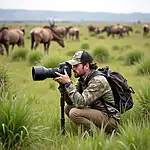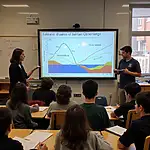The integration of creative arts into environmental education is an innovative approach that combines artistic expression with ecological awareness. This IELTS Reading practice test explores this fascinating intersection, challenging your comprehension skills while introducing you to cutting-edge educational concepts.
The role of arts education in developing creativity is increasingly recognized as crucial in modern learning environments. Let’s dive into a comprehensive IELTS Reading test that examines how creative arts are being woven into environmental education.
Passage 1 – Easy Text
The Fusion of Art and Nature
In recent years, educators have been exploring innovative ways to engage students in environmental studies. One particularly effective method has been the integration of creative arts into environmental education. This approach not only enhances students’ understanding of ecological concepts but also fosters a deeper emotional connection to nature.
The fusion of art and nature in education takes many forms. For instance, students might be asked to create sculptures from natural materials found in local environments. This hands-on activity encourages them to observe and appreciate the textures, colors, and shapes present in nature. Similarly, photography projects focused on capturing local flora and fauna can help students develop a keen eye for detail and a greater appreciation for biodiversity.
Another popular technique is the use of nature journaling. This practice combines scientific observation with artistic expression, encouraging students to record their observations through both written notes and sketches. This interdisciplinary approach helps reinforce scientific concepts while also nurturing creativity and self-expression.
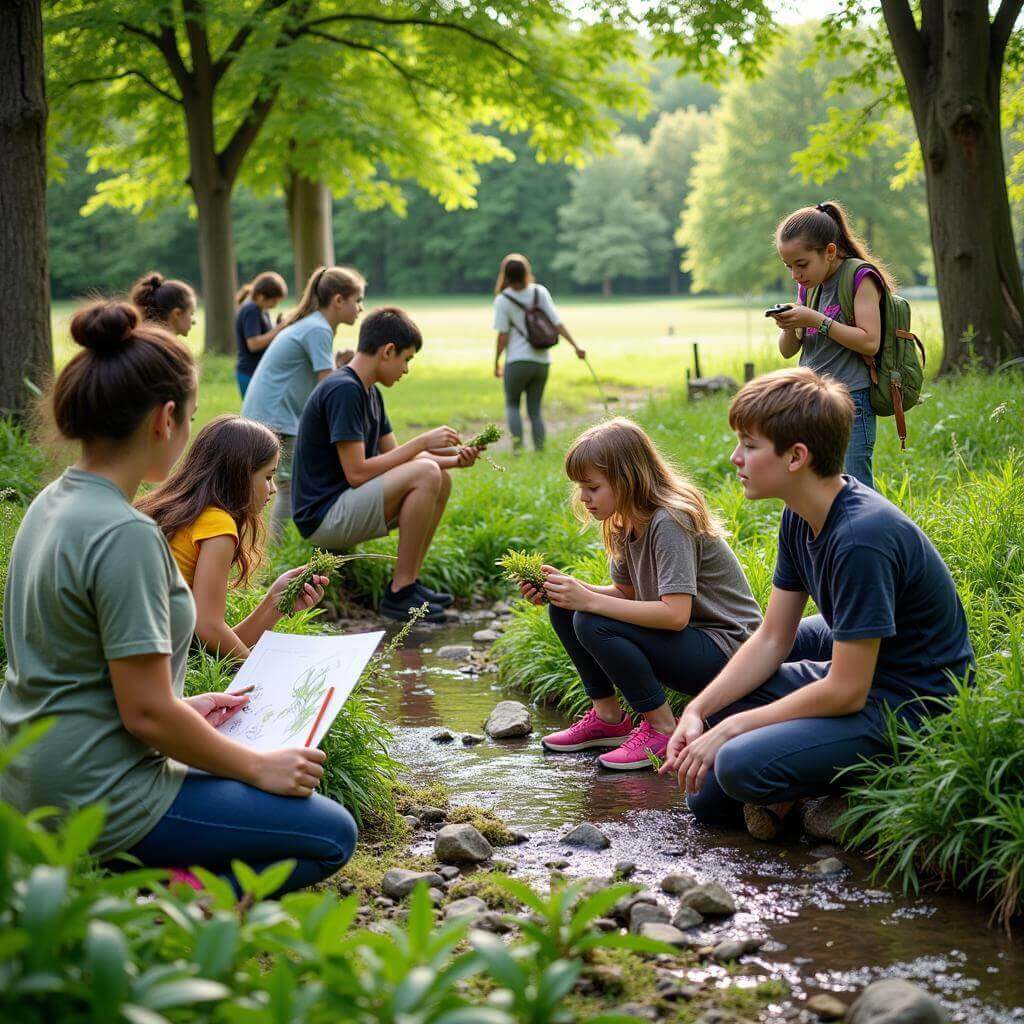 Creative arts integrated into environmental education
Creative arts integrated into environmental education
The benefits of this integrated approach are numerous. Students often report increased engagement and motivation when artistic elements are incorporated into their environmental studies. Moreover, the creative process can lead to a more profound understanding of complex ecological relationships, as students are required to synthesize information in novel ways.
Importantly, this method also cultivates empathy for the natural world. By engaging with nature on an artistic level, students often develop a stronger emotional connection to their environment. This emotional investment can translate into a greater commitment to environmental conservation and sustainable practices in their daily lives.
How technology is influencing the way students learn about art is also playing a role in this integration. Digital tools and platforms are being used to create virtual art exhibitions focused on environmental themes, allowing students to share their work and ideas with a broader audience.
As environmental challenges continue to grow in complexity and urgency, the need for innovative educational approaches becomes increasingly apparent. The integration of creative arts into environmental education represents a promising strategy for nurturing the next generation of environmentally conscious citizens.
Questions 1-7
Do the following statements agree with the information given in the Reading Passage?
Write
TRUE if the statement agrees with the information
FALSE if the statement contradicts the information
NOT GIVEN if there is no information on this
-
Creative arts integration in environmental education is a new concept that has only been implemented in the last year.
-
Creating sculptures from natural materials helps students appreciate nature’s textures and colors.
-
Nature journaling combines scientific observation with artistic expression.
-
Students generally find environmental studies less engaging when artistic elements are included.
-
The integration of art and nature in education can lead to a stronger emotional connection to the environment.
-
Digital tools are being used to create virtual art exhibitions on environmental themes.
-
All schools have adopted this integrated approach to environmental education.
Questions 8-13
Complete the sentences below.
Choose NO MORE THAN TWO WORDS from the passage for each answer.
-
Students might be asked to create ___ from materials found in nature.
-
___ projects focused on local wildlife can help students appreciate biodiversity.
-
Nature journaling encourages students to record observations through notes and ___.
-
The creative process can lead to a more profound understanding of complex ___ relationships.
-
Engaging with nature artistically can cultivate ___ for the natural world.
-
The integration of creative arts into environmental education aims to nurture environmentally ___ citizens.
Passage 2 – Medium Text
The Ecological Artist: Bridging Science and Creativity
The emergence of ecological art, or “eco-art,” represents a significant shift in both the art world and environmental education. This interdisciplinary field brings together artists, scientists, and educators to create works that not only aesthetically engage viewers but also communicate complex environmental concepts and promote ecological awareness.
Ecological artists often collaborate with environmental scientists to ensure their work is grounded in rigorous scientific understanding. These collaborations can take various forms, from large-scale installations that visualize climate data to participatory projects that involve communities in local conservation efforts. For instance, the artist Nils-Udo creates ephemeral sculptures using natural materials, photographing them before they decompose. His work serves as a poignant reminder of nature’s cycles and the transient beauty of ecosystems.
The influence of art movements on education has been profound, and eco-art is no exception. In educational settings, eco-art projects provide a unique opportunity for students to engage with environmental issues on both an intellectual and emotional level. For example, students might be tasked with creating a mural that depicts the water cycle, using recycled materials to emphasize the importance of resource conservation.
One of the most powerful aspects of eco-art in education is its ability to make abstract concepts tangible. Climate change, for instance, can be a challenging topic for students to grasp due to its global scale and long-term effects. However, when students are involved in creating art that visualizes climate data or represents potential future scenarios, the issue becomes more concrete and personally relevant.
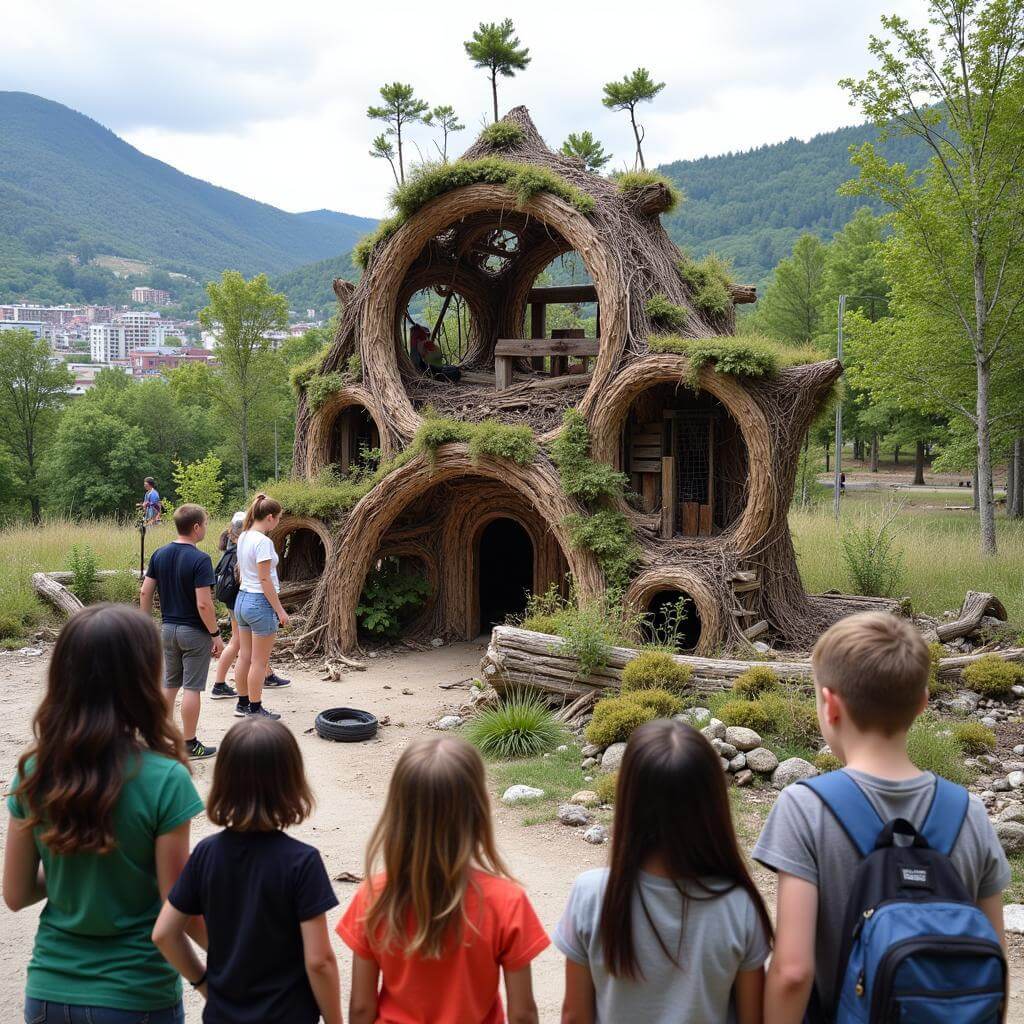 Ecological artist creating environmental awareness
Ecological artist creating environmental awareness
Moreover, eco-art projects often encourage students to think critically about their local environments. By engaging in site-specific art creation, students develop a deeper understanding of local ecosystems, biodiversity, and environmental challenges. This localized approach can lead to increased environmental stewardship and a sense of connection to place.
The pedagogical value of eco-art extends beyond environmental education. These projects often require collaboration, problem-solving, and creative thinking – all essential skills for the 21st-century workforce. Additionally, the interdisciplinary nature of eco-art helps students recognize the interconnectedness of different fields of study, breaking down traditional subject silos.
However, integrating eco-art into curriculum is not without challenges. It requires educators to be comfortable with interdisciplinary teaching and often demands more flexible learning spaces and schedules. There’s also the need for resources and materials, which can be a constraint for some schools.
Despite these challenges, the potential benefits of eco-art in environmental education are significant. By bridging the gap between science and creativity, eco-art offers a powerful tool for fostering environmental literacy and inspiring the next generation of environmental stewards. As our planet faces increasingly complex ecological challenges, nurturing this synthesis of art and science in education may prove crucial in developing innovative solutions for a sustainable future.
Questions 14-19
Choose the correct letter, A, B, C, or D.
-
What is the main purpose of ecological art?
A) To replace traditional art forms
B) To communicate environmental concepts and promote awareness
C) To provide employment for artists
D) To criticize scientific research -
How do ecological artists ensure their work is scientifically accurate?
A) By obtaining formal scientific qualifications
B) By collaborating with environmental scientists
C) By conducting their own research
D) By focusing solely on aesthetics -
According to the passage, what is one benefit of eco-art projects in education?
A) They replace traditional science lessons
B) They make abstract concepts more tangible
C) They are less time-consuming than other methods
D) They eliminate the need for textbooks -
How does eco-art help students understand climate change?
A) By simplifying the science
B) By ignoring long-term effects
C) By making the issue more concrete and personally relevant
D) By focusing only on global impacts -
What skill is NOT mentioned as being developed through eco-art projects?
A) Collaboration
B) Problem-solving
C) Creative thinking
D) Foreign language proficiency -
What is described as a challenge in integrating eco-art into curriculum?
A) Student disinterest
B) Lack of artistic talent among teachers
C) The need for more flexible learning spaces and schedules
D) Opposition from parents
Questions 20-26
Complete the summary below.
Choose NO MORE THAN TWO WORDS from the passage for each answer.
Ecological art, or “eco-art,” is an interdisciplinary field that combines art, science, and education. Artists often work with (20) to ensure their work is scientifically accurate. In educational settings, eco-art projects help students engage with environmental issues both intellectually and emotionally. These projects can make (21) concepts more tangible and personally relevant to students. By focusing on (22) art creation, students develop a deeper understanding of local environments and environmental challenges. This can lead to increased environmental (23) and a stronger connection to place. Eco-art projects also develop important skills such as collaboration and (24) . However, integrating eco-art into the curriculum can be challenging, requiring (25) teaching approaches and often more flexible learning spaces. Despite these challenges, eco-art is seen as a powerful tool for fostering environmental literacy and inspiring future (26) ___ of the environment.
Passage 3 – Hard Text
The Synergistic Paradigm: Integrating Creative Arts and Environmental Science in Education
The integration of creative arts into environmental education represents a paradigm shift in pedagogical approaches to ecological literacy. This synergistic model, which amalgamates artistic expression with scientific inquiry, is gaining traction as an effective means of fostering a more profound and multifaceted understanding of environmental issues among students. The confluence of these seemingly disparate disciplines engenders a holistic learning experience that not only enhances cognitive comprehension but also nurtures emotional intelligence and cultivates a sense of environmental stewardship.
At the core of this integrated approach lies the principle of embodied cognition, which posits that the human mind is not only connected to the body but that the body influences the mind. In the context of environmental education, this principle manifests in the form of kinesthetic learning experiences that engage students in physical, artistic activities related to ecological concepts. For instance, students might participate in land art installations, creating ephemeral sculptures from natural materials to explore concepts of biodiversity and ecosystem interdependence. These tactile experiences serve to concretize abstract ecological principles, rendering them more accessible and memorable.
How cultural heritage influences modern education is particularly relevant in this context, as many indigenous cultures have long recognized the intrinsic connection between art, nature, and learning. By incorporating elements of traditional ecological knowledge and artistic practices, educators can foster a more inclusive and culturally responsive environmental curriculum.
The cognitive benefits of integrating creative arts into environmental education are multifaceted. Research has shown that artistic engagement activates multiple neural pathways, facilitating enhanced information processing and retention. Moreover, the act of artistic creation necessitates critical thinking and problem-solving skills, as students must synthesize complex ecological information and translate it into visual, auditory, or performative representations. This process of transmediation – moving information from one sign system to another – deepens understanding and encourages students to approach environmental issues from multiple perspectives.
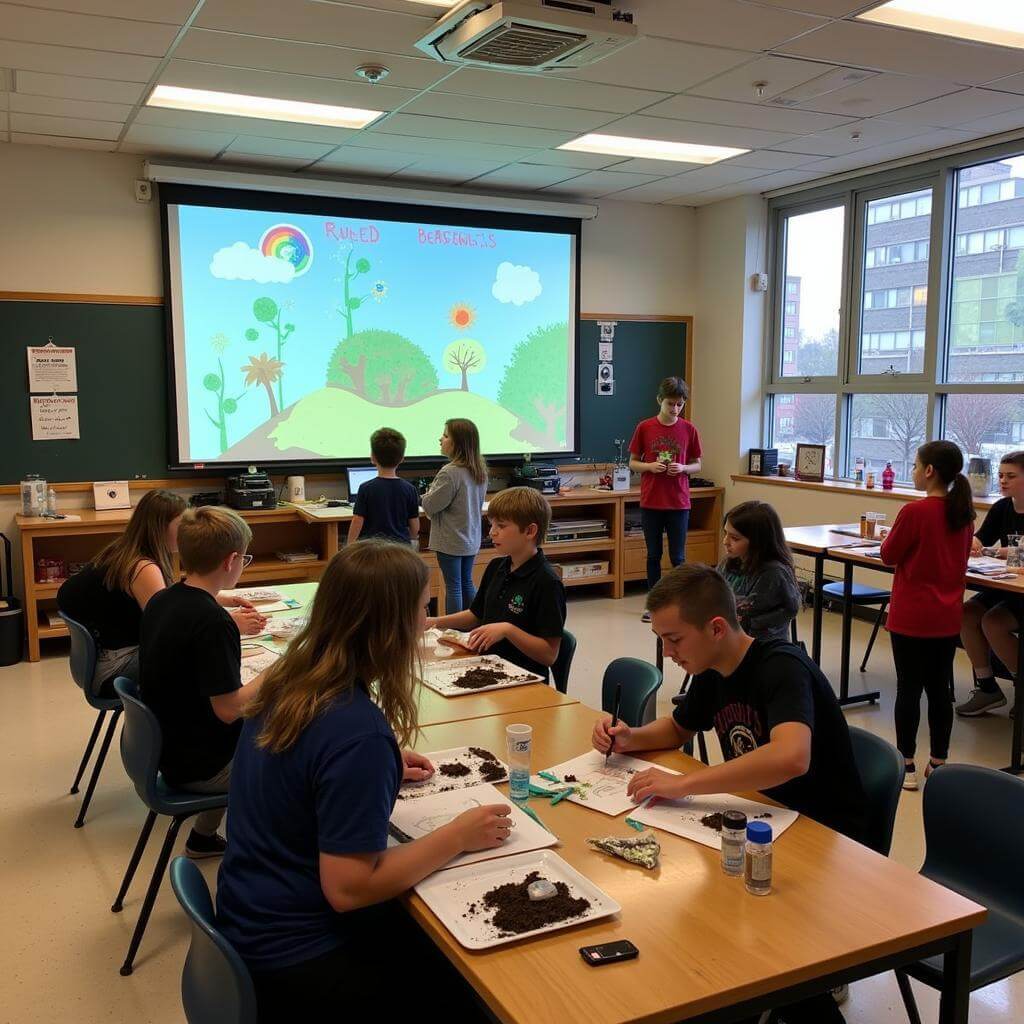 Integration of creative arts and environmental science in education
Integration of creative arts and environmental science in education
Furthermore, the integration of creative arts into environmental education serves as a powerful tool for developing emotional intelligence and fostering empathy for the natural world. Artistic expression provides a channel for students to explore and articulate their feelings about environmental issues, which can be particularly valuable when dealing with emotionally charged topics such as climate change or species extinction. This emotional engagement can lead to a deeper sense of connection with nature and a stronger commitment to environmental conservation.
The pedagogical approach of integrating creative arts and environmental science also aligns with the principles of constructivist learning theory. This theory emphasizes the importance of active, experiential learning in which students construct their own understanding through hands-on experiences and reflection. By engaging in artistic projects related to environmental themes, students are not merely passive recipients of information but active creators of knowledge.
However, the implementation of this integrated approach is not without challenges. It requires educators to possess a diverse skill set spanning both the arts and sciences, as well as the ability to facilitate interdisciplinary learning experiences. Additionally, assessment of learning outcomes in this integrated model can be complex, necessitating the development of new evaluation frameworks that can capture both scientific understanding and artistic expression.
Despite these challenges, the potential benefits of integrating creative arts into environmental education are profound. This approach has the capacity to nurture a new generation of environmentally literate citizens who possess not only a deep understanding of ecological principles but also the creative problem-solving skills and emotional intelligence necessary to address complex environmental challenges.
As we navigate the Anthropocene – an era defined by human impact on the planet – the need for innovative educational approaches that can foster both ecological understanding and creative thinking becomes increasingly urgent. The integration of creative arts into environmental education offers a promising pathway towards this goal, equipping students with the knowledge, skills, and emotional resilience to become effective stewards of the Earth’s ecosystems.
Questions 27-31
Choose the correct letter, A, B, C, or D.
-
What is the main idea behind integrating creative arts into environmental education?
A) To replace traditional science education
B) To create a more holistic learning experience
C) To focus solely on artistic expression
D) To simplify complex scientific concepts -
According to the passage, what is ’embodied cognition’?
A) The idea that the mind is separate from the body
B) The concept that physical activities can enhance learning
C) A theory that art and science are incompatible
D) The belief that environmental education should be purely theoretical -
How does artistic engagement benefit cognitive processes?
A) By activating multiple neural pathways
B) By replacing scientific thinking
C) By focusing solely on visual learning
D) By simplifying complex ideas -
What is ‘transmediation’ in the context of this passage?
A) The process of translating books into films
B) Moving information from one sign system to another
C) The act of creating art without any scientific basis
D) A method of teaching only through visual aids -
What challenge is mentioned in implementing this integrated approach?
A) Students’ lack of interest in environmental issues
B) The high cost of art supplies
C) The need for educators with diverse skills in arts and sciences
D) The lack of scientific evidence supporting the approach
Questions 32-36
Complete the sentences below.
Choose NO MORE THAN THREE WORDS from the passage for each answer.
-
The integration of creative arts and environmental science in education is described as a ___ in pedagogical approaches.
-
Land art installations allow students to explore concepts of biodiversity and ___.
-
Artistic engagement in environmental education can help develop students’ ___ and foster empathy for nature.
-
The integrated approach aligns with the principles of ___, which emphasizes active, experiential learning.
-
The era defined by human impact on the planet is referred to as the ___.
Questions 37-40
Do the following statements agree with the claims of the writer in the Reading Passage?
Write
YES if the statement agrees with the claims of the writer
NO if the statement contradicts the claims of the writer
NOT GIVEN if it is impossible to say what the writer thinks about this
-
The integration of creative arts into environmental education is universally accepted by all educators.
-
Indigenous cultures have long recognized the connection between art, nature, and learning.
-
Emotional engagement with environmental issues through art always leads to conservation action.
-
The integrated approach to environmental education can help develop problem-solving skills needed to address complex environmental challenges.
Answer Keys
Passage 1
- NOT GIVEN
- TRUE
- TRUE
- FALSE
- TRUE
- TRUE
- NOT GIVEN
- sculptures
- Photography
- sketches
- ecological
- empathy
- conscious
Passage 2
- B
- B
- B
- C
- D
- C
- environmental scientists
- abstract
- site-specific
- stewardship
- problem-solving
- interdisciplinary
- stewards
Passage 3
- B
- B
- A
- B
- C
- paradigm shift

